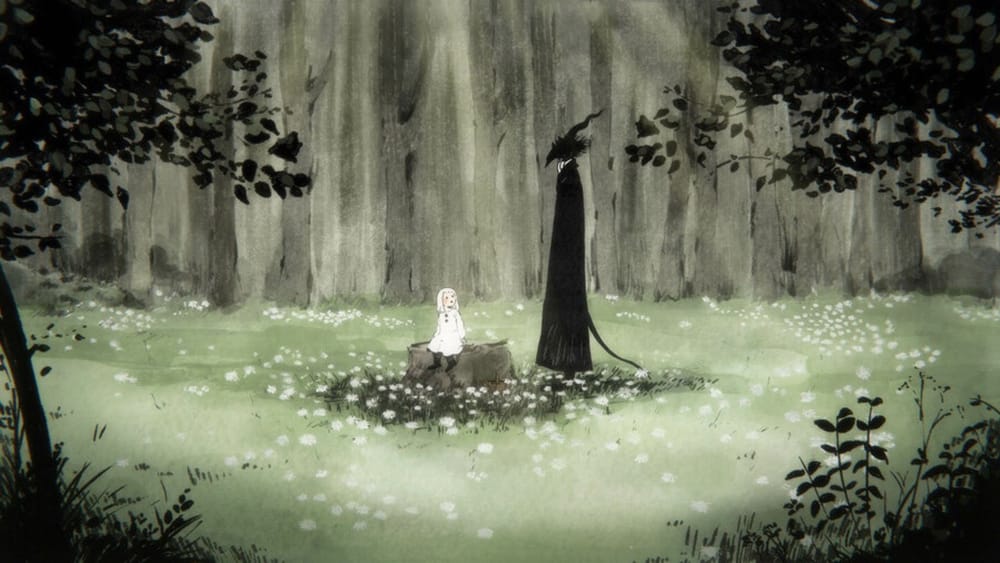Film Review: The Girl from the Other Side
by Blair E. Vandehey
While wandering aimlessly through the trees of the Outside forest, an unnamed Outsider (later named ‘Teacher’ by the titular character, played by Jun Fukuyama) stumbles upon young Shiva (Rie Takahashi), a human girl abandoned by her Inside village. Be it by coincidence or fate, the two form a relationship that transcends borders–borders between the Outside and Inside, borders between human and otherwise, and borders between blood family and family bound by love. Based on a story by Nagabe, which in turn was inspired by the Irish folk song “Siúil, a Rún,” three-part short film The Girl from the Other Side reimagines the boundaries of animation and genre as it tells a hauntingly beautiful story of two lost souls finding themselves together.
The Girl from the Other Side is reminiscent of a familial version of Beauty and the Beast, with an ostracized human character and a feared nonhuman character discovering an unexpected solace within one another. Teacher steps into the role of parent for previously-unwanted Shiva, protecting her from the harm the Outside poses to Insiders and therefore creating an environment allowing her to experience every carefree joy childhood has to offer. Likewise, Shiva’s overflowing daughterly love for Teacher, who previously thought himself unlovable in his cursed form, disrupts the loneliness of his isolation on the Outside and leads him towards a path of self-acceptance, proving that ‘nonhuman’ and ‘inhuman’ are not synonymous.
Everything about The Girl from the Other Side takes place in “the hazy twilight that separates night from day.” This is not only true for its plot but also for its atmosphere; the film expertly presents itself as a gothic intermediary between horror and non-horror. Unsettling moments in which Shiva witnesses lost souls eroded by the curse appear alongside more blissful instances of she and Teacher bonding over the art of the pancake. The eerie larger setting of a woods crawling with inhuman beings contrasts the immediate setting of an abandoned house made home by a found family of father and daughter. It has all the elements of a fantasy-horror—supernatural forces, a deep dark forest, and corrosive curses—and yet, its use of them as a backdrop to the main story of Teacher and Shiva’s familial relationship helps dim the fear factor, making the story perfect for both horror lovers and the opposite.
This atmospheric dichotomy is created in part by The Girl from the Other Side’s unique artstyle. Muted shades paint each scene, with emphasis on cooler colors such as black, brown, and dark green to create a mysterious and disquieting (yet not overly frightening) world for the story to take place in. The lines of the story’s both living and nonliving figures are fittingly undefined, allowing color to permeate them unlike many other works of animation which use bold lines in their characters, settings, and beyond. The artstyle, in turn, similarly enhances the story’s more contented side; just as Teacher and Shiva accidentally blend into each other’s lives, watercolor splashes bleeding across sketchy penciling underlines the imperfection–and yet happy coincidence–of the relationship they form.

By the ending of The Girl from the Other Side, brighter colors in bolder shades begin to creep in, such as the sunset marbled with glowing orange and rosy pinks that Teacher and Shiva walk through on their way back home and the blue sky that backgrounds their travels into the next day. Even the duller colors already present become more vibrant and varied, like the multi-shade greens that give new depth to the grass or the deep chestnut brown of the home they return to.
In every sense of the word, The Girl from the Other Side is a work of great ambiguity, none more so than in the ending. Believing that Shiva would be better off with the human Insiders, Teacher embarks on a journey with her (none the wiser to what he intends to do) to find a village that will take her in. On their travels, the reason for her abandonment comes to light, leading Teacher to make a wish to a higher power called “Mother” for Shiva’s freedom from that reason, having realized something like paternal love again. After a sequence of either the power granting that wish or Teacher realizing the power within him to at least try to change her fate, it is left up to interpretation whether the wish was granted. Either way, however, one thing is for certain–whatever awaits the two beyond is irrelevant in that moment as the two return to their home together once more.
Both literally and figuratively defying the lines so many other animated works have been created in, The Girl from the Other Side takes an intimate glimpse into the lives and the love of an unlikely pair. At around just an hour runtime, the film brings the unordinary out of the seemingly ordinary and vice-versa as a supernatural and a girl from the other side find their peace alongside the other.
Blair E. Vandehey is an Appleton-based writer, daydreamer, and lover al all things pop culture. She is currently working towards degree in Creative Writing and Political Science at Lawrence University.




